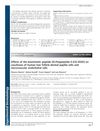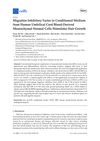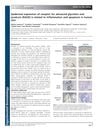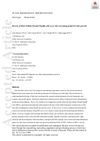sh-Polypeptide-7
sh-Polypeptide-7 is the official cosmetic industry name for a synthetic peptide fragment of human growth hormone (hGH), also known as Somatotropin. The "sh-" prefix signifies it is a "synthetic human" molecule, created through biotechnology to be structurally similar to a human protein without being sourced from human tissue. It is produced using recombinant DNA technology, where a gene for the desired hGH fragment is inserted into a microorganism, typically E. coli, which then produces the peptide through fermentation.
Despite marketing claims suggesting potent biological activity related to hair growth, its official registered functions are conservative: "skin protecting," "antiseborrhoeic" (regulating oil production), and "humectant" (moisturizing). This allows brands to market the ingredient's potential while classifying the final product as a cosmetic rather than a drug, thus avoiding stricter pharmaceutical regulations.
To understand how sh-polypeptide-7 might work, it is essential to understand the basics of hair biology. Hair follicles cycle through three main phases: anagen (active growth), catagen (transition), and telogen (rest). The length of the anagen phase, which can last for years, determines how long hair can grow. In a healthy scalp, about 85-90% of follicles are in the anagen phase.
The dermal papilla, a cluster of specialized cells at the base of the follicle, acts as the command center, using growth factors to signal when a hair should grow, rest, or shed. Conditions like androgenetic alopecia (pattern hair loss) disrupt this cycle. The hormone dihydrotestosterone (DHT) causes genetically susceptible follicles to miniaturize by shortening the anagen phase and lengthening the telogen phase. Over time, this results in finer, shorter hairs and visible thinning. Any effective hair loss treatment must work by prolonging the anagen phase or encouraging follicles to re-enter it from the telogen phase.
The proposed benefits of sh-polypeptide-7 are based on its ability to mimic the local actions of human growth hormone on the scalp. Its mechanism is believed to be multi-faceted, aiming to create a more favorable environment for hair growth.
The primary theory is that it directly stimulates the proliferation of key cells in the hair follicle, supporting and prolonging the anagen (growth) phase. By binding to growth hormone receptors on follicle cells, it is thought to "turn on" weakened or resting follicles.
A key secondary effect is the induction of other growth factors, most notably Insulin-like Growth Factor 1 (IGF-1). hGH signaling is known to trigger the local production of IGF-1, which is itself a potent promoter of the anagen phase. This creates a cascade effect, amplifying the pro-growth signal within the scalp.
Finally, sh-polypeptide-7 is believed to improve the overall scalp microenvironment. This includes enhancing vascularization (the formation of new blood vessels) to ensure a rich supply of oxygen and nutrients to active follicles. It may also provide anti-inflammatory effects, protecting follicles from the chronic micro-inflammation that contributes to hair loss.
While the proposed mechanisms are scientifically plausible, the clinical evidence for sh-polypeptide-7's efficacy is limited and requires critical evaluation. Preclinical lab studies on pools of various biomimetic peptides have shown they can positively influence cultured human hair follicles, providing a proof-of-concept for this class of ingredients.
However, the most direct evidence comes from commercial products, and this data has significant limitations. There is a critical lack of independent, peer-reviewed, randomized, double-blind, placebo-controlled clinical trials that evaluate sh-polypeptide-7 as a standalone ingredient.
The available evidence is weakened by two major confounding variables:
The "Cocktail" Formulation: sh-Polypeptide-7 is always used in complex mixtures with other bioactive ingredients like Copper Tripeptide-1, Niacinamide, and other growth factors. These ingredients have their own beneficial properties, making it impossible to isolate the specific contribution of sh-polypeptide-7 to the observed results.
The Procedural Component: The most impressive results are associated with professional treatments that pair the peptide serum with a physical procedure. Hydrafacial Keravive involves mechanical exfoliation and suction, while KeraFactor is often combined with microneedling or laser therapy. These procedures independently stimulate the scalp and dramatically enhance product penetration, meaning a large part of the benefit is likely due to the procedure itself.
In summary, while there is encouraging preliminary data, the clinical efficacy of sh-polypeptide-7 remains unproven by high scientific standards.
Formulation and Commercial Applications
The commercial application of sh-polypeptide-7 relies on sophisticated formulation strategies to be effective. As a large peptide molecule, it cannot easily penetrate the skin's outer barrier. To overcome this, brands utilize advanced delivery systems, most commonly nanoliposome encapsulation. This technology wraps the peptide in a microscopic lipid bubble, which protects it from degradation and helps it penetrate deeper into the scalp to reach the hair follicle.
Furthermore, sh-polypeptide-7 is almost always featured as part of a proprietary "peptide complex" or "cocktail." These formulas blend it with other growth factors, peptides, vitamins like Niacinamide, and anti-inflammatory botanicals. This holistic approach aims to address scalp health from multiple angles at once. The most potent applications are in professional settings, where its delivery is enhanced by procedures like microneedling, fractional lasers, or hydro-exfoliation, which create micro-channels in the scalp for maximum absorption.
Safety and Regulatory Profile
sh-Polypeptide-7 is generally considered to have a favorable safety profile for topical use. As large molecules, peptides have limited systemic absorption, meaning their effects are localized to the skin and the risk of systemic side effects is minimal. Safety assessments of finished products typically show a very low potential for skin irritation or allergic reaction.
Regulatorily, sh-polypeptide-7 is classified as a cosmetic ingredient in major markets like the United States and the European Union. The key challenge for brands is navigating the boundary between a cosmetic and a drug. A product's legal classification depends on its marketing claims. Claims related to improving the appearance of hair are cosmetic, while claims to "treat alopecia" or "regrow hair" would classify the product as a drug, requiring a rigorous approval process. Brands are therefore careful to use cosmetic language to describe their products' benefits.
Conclusion
sh-Polypeptide-7 is a scientifically intriguing ingredient that represents the cutting edge of cosmeceuticals for hair care. Its theoretical mechanism—mimicking human growth hormone to stimulate follicles and improve the scalp environment—is strong and aligns with modern understandings of hair biology.
However, there is a significant gap between this promise and the available proof. Its clinical efficacy as a standalone ingredient is not yet validated by rigorous, independent scientific studies. Its success in the market is heavily dependent on its inclusion in synergistic, multi-ingredient formulas and its pairing with professional procedures that enhance its delivery.
For consumers and clinicians, sh-polypeptide-7 should be viewed as a supportive component within a comprehensive, systems-based approach to scalp health, rather than a singular solution for hair loss. Its future in the therapeutic landscape will be defined by the rigorous clinical validation that is currently lacking.
Research
20 / 1000+ resultsresearch Hair Growth Booster Effects of Micro-Needling With Low-Level LED Therapy and Growth Factors on Subjects Treated With Finasteride

research Clinical Study on the Efficacy and Tolerability of a Topical Regenerative Treatment in Patients With Telogen Effluvium and Mild Androgenetic Alopecia

research Preliminary Investigation on Microneedling with Low-Level LED Therapy and Growth Factors in Hair Loss Related to COVID-19
research Regenerative Biotechnologies in Plastic Surgery: A Multicentric, Retrospective, Case-Series Study on the Use of Microneedling with Low-Level Light/Laser Therapy as a Hair Growth Boost in Patients Affected by Androgenetic Alopecia

research Effects of the Biomimetic Peptide Sh-Polypeptide 9 (CG-VEGF) on Cocultures of Human Hair Follicle Dermal Papilla Cells and Microvascular Endothelial Cells

research Vacuum Therapy with Plant Active Compounds, Prebiotics, and Probiotics for Androgenetic Alopecia, Female Pattern Hair Loss, and Telogen Effluvium: Follow-up Study

research QR 678 and QR678 Neo vs PRP—A Randomized, Comparative, Prospective Study
research Centella Asiatica L. Urb. Extracellular Vesicle and Growth Factor Essence for Hair and Scalp Health: A 56-Day Exploratory Randomized Trial

research Migration Inhibitory Factor in Conditioned Medium from Human Umbilical Cord Blood-Derived Mesenchymal Stromal Cells Stimulates Hair Growth

research Efficacy of Postbiotics in a PRP-Like Cosmetic Product for the Treatment of Alopecia Areata: A Randomized Double-Blinded Parallel-Group Study
research QR678 and QR678 Neo Hair Growth Formulations: A Cellular Toxicity and Animal Efficacy Study

research Evaluation of Efficacy of QR 678 and QR678 Neo Hair Growth Factor Formulation for the Treatment of Female Pattern Alopecia in Patients with PCOS—A Prospective Study

research Epidermal Expression of Receptor for Advanced Glycation End Products (RAGE) Is Related to Inflammation and Apoptosis in Human Skin

research Randomized Controlled Trial on a PRP-Like Cosmetic with Biomimetic Peptides for the Treatment of Alopecia Areata

research Review of Hair Follicle Dermal Papilla Cells as In Vitro Screening Model for Hair Growth

research Serenoa Repens and N-Acetyl Glucosamine/Milk Proteins Complex Differentially Affect the Paracrine Communication Between Endothelial and Follicle Dermal Papilla Cells

research A Newer Approach in the Treatment of Seborrheic Dermatitis With QR678 and QR678 Neo: A Prospective Pilot Study

research Efficacy of Platelet-Rich Plasma Versus Mesotherapy with Recombinant Growth Factors and Stem Cell-Conditioned Media in Androgenetic Alopecia: A Retrospective Study
research Comparative Clinical Assessment of 5% Minoxidil Topical Application with Supplemental Intradermal Meso-Solution Administration for the Management of Androgenetic Alopecia in Men
